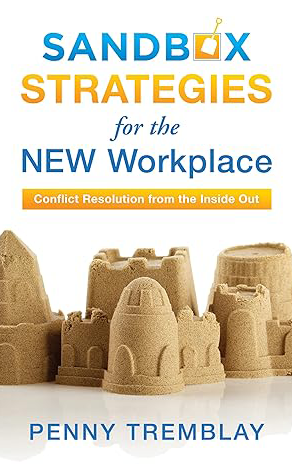I was once working on an important project when the person sitting next to me hit me in the head with a brick. A very early taste of conflict; I was four.
My attacker – my sister – was two. We were on the rug in our living room, playing with wooden bricks. And something about my work on the castle we were building together must not have been to her liking. Because she suddenly picked up the biggest brick she could see and whacked me with it.
There was a little blood, lots of tears, and my sister was hauled away to a safe distance. And, thankfully, she never did it again. Instead, like most people, she steadily improved her ability to share, negotiate, resolve problems, and get her feelings across without resorting to violence.
There were blips along the way (and I’m sure I was no angel). But she learned to be creative with others in a much calmer and more collaborative way. Which was good for my health and safety and, as I’ve come to realize, an essential part of growing up.
Sadly, not everyone at work is quite there yet.
Workplaces at War
In her new book, “Sandbox Strategies for the New Workplace,” Penny Tremblay imagines work as a place where we should be able to be creative with a wide range of people, explore what’s possible, combine our talents, and have fun while we’re at it. Just like children playing in the sand (or on a living-room rug).
However, we’re worse at it than ever, even with many of us now working remotely. In fact, research shows we’re experiencing more conflict than before the pandemic, not less.

So, whether it comes from a sense of unfairness about flexible work hours, personality clashes in virtual meetings, feelings of disconnection – and even exclusion – within a hybrid team, or any number of other potential triggers, Tremblay says that we need to be better at handling conflict than ever before.
And her solution is to look back to childhood – to see the skills that worked well in the sandbox.
Sandbox Strategies for Conflict
These aren’t skills for avoiding conflict altogether. After all, great collaboration involves working through conflicting situations and embracing different viewpoints. As well as sometimes confronting unappealing topics to find healthy, creative solutions.
My sister and I would likely have built a better castle if we’d explored our different ideas and pooled our talents. Confrontation doesn’t have to mean beating others over the head, figuratively or literally.
Instead, Tremblay’s “sandbox strategies” are ways to benefit from the energy created by the “right kind of conflict.” They also bid to protect everyone involved. She paints a glossy picture of children at play, engrossed in a shared activity, experimenting, negotiating, working through any problems as they emerge. All the while constantly improving their coworking skills. And she outlines eight steps to success in her idealized sandbox – brought together in the acronym, “PLAY NICE.”
Play Nice!
P, for example, is “position yourself for success.” You have to be in the right mental and emotional state to cope with conflict. And preparing for new challenges often means dealing with unresolved conflicts first, or you might bring lots of negative ideas along with you.
As a parent, and especially during a decade working in schools, I often saw children struggling with situations before they’d even started. They’d be worrying about a play date or stressed about a group activity, because of negative experiences in the past.
L is for “lighten your load.” Deal with the emotions that are creating conflict for you, or are stopping you from engaging with conflict bravely and positively.
The A in PLAY NICE is “actively listen.” How often do kids – and adults – fall out because they don’t or won’t listen properly to what other people think or need?
And so, step by step, the PLAY NICE approach supports enjoyable, effective coworking, where conflict can be confronted, not dodged. And it leads to what the author calls “assertive play.” Not brick-on-skull assertive, or even domineering or aggressive. But self-confident engagement, where people know they have things to contribute, and stake their claim to be fully involved.
The N is particularly important for that: “nurture relationships.” However old we are, it’s hard to suddenly start being collaborative and creative. You need to build trusting bonds over time. Looking back, I could have done more to make my little sister feel included in our castle-building game.
Conflict: Who’s Being Left Out?
So I was particularly drawn to Tremblay’s theme of inclusion. Again, parenting and teaching have both taught me that conflict often arises when people feel left out.
So, as we get to grips with virtual and hybrid working, we need to see when people aren’t being involved. Where they’re being are left out of decision making, or are excluded from social events. Think of the child left to look on as others play a game, or not invited to that big party.
At work, conflicts that stem from inclusion – creating negative feelings and maybe even challenging behavior – can seriously damage the performance of individuals and teams.
In contrast, getting everyone to “play nice” gives you access to a range of experiences. It also promotes a rich diversity of ideas, and keeps everyone involved in tackling conflicts together. Then moving on.
Time to Grow Up?
The sandbox analogy only goes so far, of course. Different rules apply to children and adults – along with different consequences when things go wrong. Usually, when a child’s playtime is over, someone else cleans up the mess.
What’s more, as the book makes clear, serious conflict – like harassment or bullying – is anything but a childish matter, and needs to be dealt with way beyond the realm of “play.”
However, it feels like we can learn much about dealing with conflicts now by considering the things we learned as kids. Like how to go into challenges with curiosity; include everyone in our games; compromise when necessary. And how we can achieve great things through creative differences and keep on developing our conflict skills – even when we got knocked back (by a brick to the head or otherwise).
It may feel like a stretch to compare adult workplaces with childhood sandboxes. And, I’ll be honest, at times Tremblay’s analogy comes close to falling apart.
But maybe that’s the point. Because, now more than ever, we all need to practice balancing difficult ideas, making sense of differences, combining several viewpoints: “digging in” to conflict, and building great things together.
A few years have gone by, but maybe I’ll give my sister a call and see if we can have another go at that castle.
Listen to Our “Sandbox Strategies” Book Insight
We review the best new business books and the tested classics in our monthly Book Insights, available as text or as 15-minute audio recordings.
So, if you’re a Mindtools Individual or Enterprise member, listen to the “Sandbox Strategies” Book Insight now!
If you haven’t already signed up, subscribe to Mindtools and gain access to our 2,400+ resources, including 390+ Book Insights. For corporate licensing, ask for a call with one of our team.
About the Author

Jonathan Hancock is a Senior Editor/Writer at Mindtools. In his own right he’s published 13 books about learning, written a memory column for Reader’s Digest magazine, and acted as a consultant to a number of TV shows including “Child Genius.”
Before joining Mindtools, Jonathan spent a decade in education, as a teacher and eventually a headteacher. He’s also an experienced broadcaster and event host, following 15 years working as a presenter and producer for the BBC.




